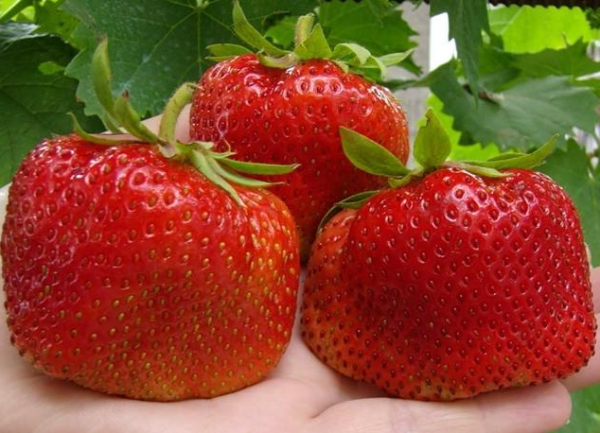One of the representatives of the Dutch species is the Vicoda strawberry. Instantly gained popularity due to its pleasant taste, delicate structure, pure natural beauty and the content of nutrients. A detailed description of this variety is presented below.
Table of contents
Vicoda strawberry description and characteristics
Vicoda is a noble variety of strawberries, the result of the work of breeders from Holland.
This variety forms a strong and tall shrub medium in height with strong thick shoots. The plant is decorated with large sheets of light green color. The top surface of the sheet plate is slightly ribbed, has small teeth along the edge. Strong petioles with small pubescence. Mustache gives little, which simplifies the care of the plant.
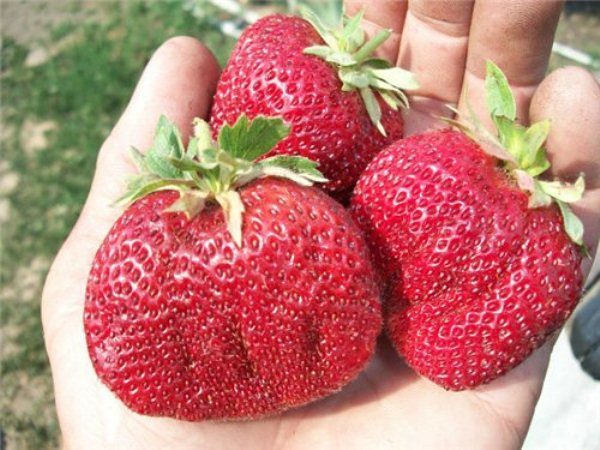
Large berries of a round shape are painted in a rich red color. The average weight of the fruit varies within 50-70 g. The weight of the first fruits can be 120 g. The tender flesh has a dense consistency and does not contain voids. Berries have a pleasant sweet-sour taste with a light fruity aftertaste, reminiscent of cherries.
Features grade
- the first fruits are large, often comb-shaped, can be doubled, and later - the correct cone-shaped form;
- sepals are easily separated from the berriesthat does not affect the crop during storage and transportation;
- appearance of white tint at the tip of the fetus signals its technical ripeness;
- is one of winter hardy varieties foreign selection.
Advantages and disadvantages
The advantages of the variety, thanks to which it deserves its place in the garden plot:
- high yield indicators, from one bush can collect up to 1 kg of sweet and juicy berries;
- large fruits with excellent taste characteristics;
- berries perfectly tolerate transportation and do not lose their presentation;
- winter hardiness as invulnerability to the complex of adverse wintering factors;
- great fitness to any climatic conditions;
- the good resistance various diseases and attacks of pests;
- berries of universal purpose, they can be eaten raw, frozen and used for harvesting for the winter.
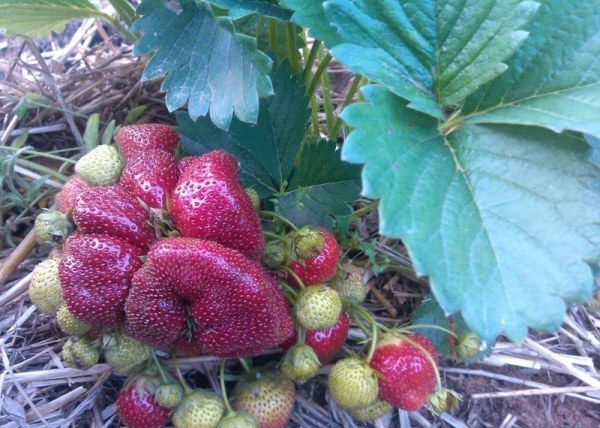
For all its numerous virtues, the Vicoda strawberry has minor drawbacks.:
- in hot weather berry density may decrease;
- bushes needed seated at a great distance from each otherthat is not very convenient in small private plots.
Agrotechnical methods for growing berries
The main parameters that will ensure the fruiting of strawberries and protect it from diseases.
Site selection for planting and soil preparation
Strawberries prefer light loam, black soil and gray forest soils, least of all like clay soil. Groundwater should be no closer than 60-80 cm. The acidity index is optimal within pH 2.7-6.2. Cereals, onions, garlic, marigolds, and petunia are considered good precursors. At one place you can grow strawberries for 3-4 years.
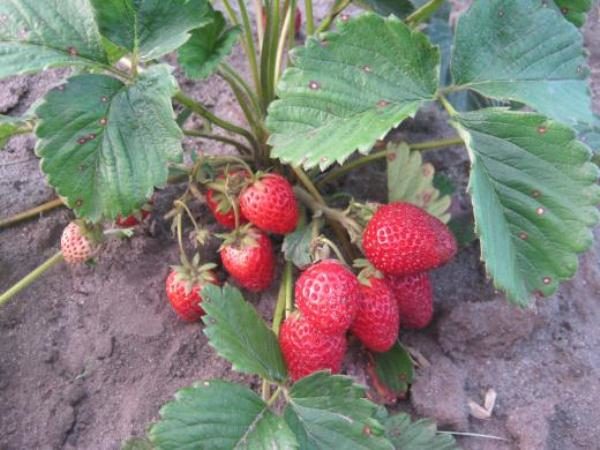
Before planting you need to destroy weeds on the site. Then add organic fertilizers and dig. Prepare the ground for spring planting need to fall. During the summer and autumn planting, the necessary work must be carried out a month before planting, in order for the earth to have time to subsist, otherwise the roots of the seedlings may become bare, which will adversely affect the development of the plant.
Selection of quality seedlings
The harvest depends on the quality of planting material. The seedlings of this variety must be different powerful, healthy plants and have:
- root neck more than 6 mm in diameter;
- fibrous root system, in processes more roots 7cm;
- 3-5 leaves and the whole apical bud.
Stages of the landing process
Seedlings need to be planted in early spring or late August - early September. Spring landing is best done when the snow melts and the earth warms up. With planting in the autumn it is important not to delay, since the seedlings will not have time to settle down and will die from frost.
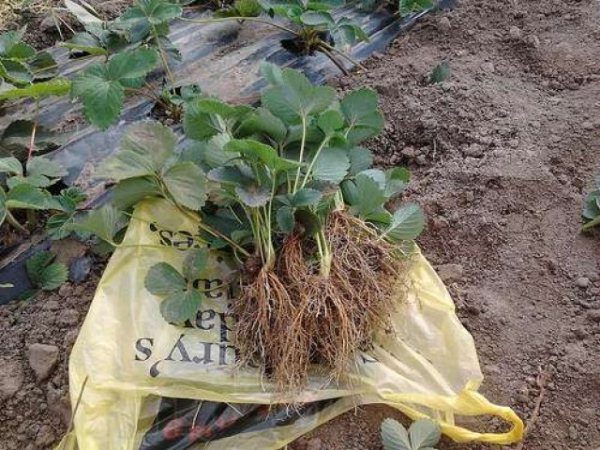
For landing choose a cloudy day. In hot weather, seedlings need for two weeks after planting pritenyat.
- On the garden form wells, keeping a distance between them is 40 cm, and between rows 50-60 cm, since with a more dense planting the plants will experience a lack of light and nutrients.
- Pour water into dug holes and start planting loosely positioning the roots of the plant, without bending them and closely covering the ground, which will allow the seedlings to settle down faster. It is important that the root neck, on which the growth point is located, be on the surface of the earth.
- The soil is well compacted and moisten a little.
- Mulching with humusto prevent the formation of a crust on the surface of the earth.
Complex care activities
For a rich harvest of tasty and juicy berries need to take care of the strawberries. The care includes the following activities.:
Watering and mulching the soil
When growing strawberries to organize high-quality irrigation system. In the spring, wet the ground every 7 days. At the time of flowering and fruiting irrigate the plant 2-3 times a week, using warm water. The optimum frequency of autumn watering 2 times before the onset of cold weather.

Mulching is required during the growing season.using straw or foil.This will keep the soil moisture and prevent cracking.
Weed control
In order not to overload the soil with chemicals, thereby ensuring the ecological purity of the fruit need to fight weed crops in the garden, by carrying out regular weeding, which should be carried out as needed.
The introduction of nutrients
For quantitative and qualitative harvest, it is tedious to feed organic matter and mineral supplements in time with a set of necessary trace elements. It is recommended to fertilize in the spring when the bushes grow, gain strength and form fruits..
Preparing for the winter

In the autumn, check the status of the root system. If it is located on the surface, then you need to sprinkle with soil. Also free the bushes from old and dry leaves. For the preservation of strawberries in the winter, you can sprinkle with a layer of sawdust or straw. With the onset of spring, this warming should be removed. For a successful wintering of the culture in November, the plantation should be covered with fir branches.
Breeding methods
Among the ways of breeding strawberries distinguish: mustache, dividing the bush and seeds.
Usa
The most famous method of obtaining planting material - growing from vegetative shoots - whiskers. The variety forms a small number of outlets, therefore should be partially removed flower stalksto direct the strength of the plant to reproduction.
At the time of fruiting to note the most berry specimens. After harvesting, the whiskers, on which the outlets were formed, should be straightened, and the socket should be slightly pressed into the ground and covered with earth, so that the hearts remain free. At the end of the summer or in September, new bushes with developed roots should be planted in a permanent place.
Dividing bush
The method of dividing the bush is used less frequently. But it is also productive and worth it to use it. For this It is necessary to plan healthy and strong bushes that have more than one top with a socket. Selected specimens dig up. Carefully separate the sockets from each other. Proper separation guarantees full plants that can bear fruit in the first year.

Plant new bushes in the prepared planting pits so that the roots of the plants are completely covered,otherwise they dry quickly. After which it is good to water.
You can separate the outlet from the main bush and transplant in a separate placewhere it will independently grow and develop.
Seeds
Seed propagation is used in obtaining new varieties. In the case of the Vicodus variety, it is not worth multiplying with seeds, because the properties of the mother plant are transferred inconsistently. There is a chance to get bushes that will have small and tasteless fruit.
Diseases and pests
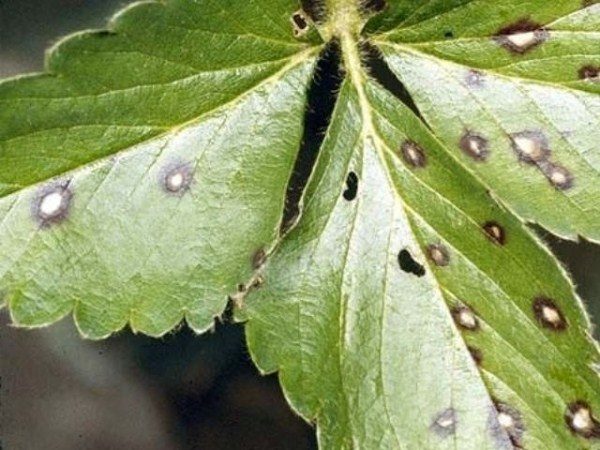
As a preventive measure, it is necessary to regularly inspect the culture for the absence of signs of damage by parasites and diseases and, if they are detected, immediately take appropriate measures. Correctly identify problems and quickly solve them will help information about diseases and pests, listed in the table..
| MAJOR DISEASES | |||
|---|---|---|---|
| title | sign | prophylaxis | control measures |
| Gray rot | The presence of brown spots on the berries and leaves with a fluffy gray bloom | To remove dry leaves and weeds, during the formation of berries, mulch between rows using straw, sawdust, pine needles,
pollinate wet shrubs and sifted wood ash
|
Damaged fruits should be collected and destroyed, treated with fungicidal action against fungal diseases |
| Mealy dew | The appearance on the green part of the bush white patina, which becomes leathery and becomes bronze in color | Do not plant bushes too thick,
time to weed between the rows of berry crops, timely thin out and plant plants |
In case of severe contamination, treat with broad-spectrum fungicides. |
| HAZARDOUS PESTS | |||
| Nematode | Slow growth, thickening of the veining of leaf plates, wilting apical buds | Do not thicken the beds,
regularly thin out rows organize the right care next to strawberries, plant, plant plants that emit fungicide (marigold, calendula), change the landing site is not less than 1 time in 4 years |
Process potent chemicals |
| Strawberry Mite | It feeds on young leaves, from which they turn yellow and deform | Spray using chemicals and folk remedies | |
Using comprehensive control and proper care for the culture can prevent the occurrence of diseases and pests on strawberry beds.
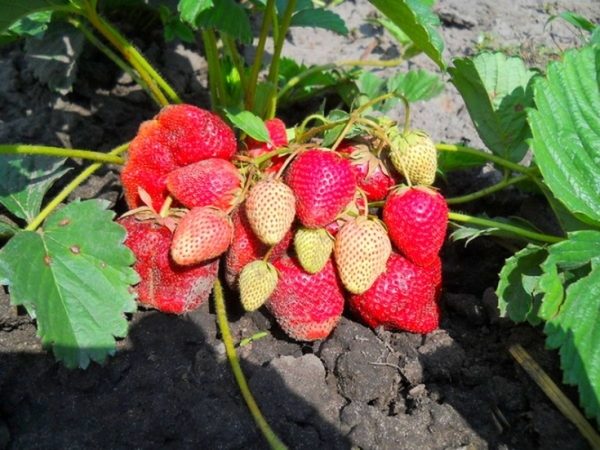
Among the many varieties of strawberries, the Vicoda deserves special attention due to its positive characteristics and healing properties. Growing and breeding this variety in the garden is not such a difficult task.as it may seem at first glance. The main thing is to observe all agrotechnical methods for growing and recommendations for care and to enjoy a tasty and healthy berry.
